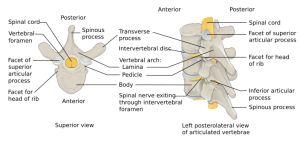Jefferson fracture: Difference between revisions
(→Workup) |
(added reference) |
||
| Line 5: | Line 5: | ||
==Clinical Features== | ==Clinical Features== | ||
*Fx of the | *Fx of the anteterior and posterior arches<ref> Jefferson, G. (1919) ‘Fracture of the atlas vertebra. Report of four cases, and a review of those previously recorded’, British Journal of Surgery, 7(27), pp. 407–422.</ref> | ||
**Due to axial loading transmitted through occipital condyles to the lateral masses | **Due to axial loading transmitted through occipital condyles to the lateral masses | ||
[[File:Jefferson fracture CT.jpg|thumb|Axial CT scan of Jefferson fracture]] | [[File:Jefferson fracture CT.jpg|thumb|Axial CT scan of Jefferson fracture]] | ||
[[File:Jeffersonfxodontoid.jpg|thumbnail|right|Odontoid View]] | [[File:Jeffersonfxodontoid.jpg|thumbnail|right|Odontoid View]] | ||
==Differential Diagnosis== | ==Differential Diagnosis== | ||
{{Cervical spine injuries}} | {{Cervical spine injuries}} | ||
Revision as of 08:49, 19 December 2015
Background
- Also known as a C1 burst fracture
- No ligamentous disruption
- Is an unstable spine injury
Clinical Features
- Fx of the anteterior and posterior arches[1]
- Due to axial loading transmitted through occipital condyles to the lateral masses
Differential Diagnosis
Vertebral fractures and dislocations types
- Cervical fractures and dislocations
- Thoracic and lumbar fractures and dislocations
Diagnosis
- Suspect disruption if:
- Lateral x-ray: Increase in the predental space between C1 and dens (>3mm in adults, >5mm in children)
- Odontoid x-ray: Masses of C1 lie lateral to outer margins of articular pillars of C2
- If either of the above findings on x-ray obtain CT C-spine
Management
Prehospital Immobilization
Hospital
- Degree of instability determined by whether or not the transverse ligament is disrupted
- C-collar
- Consult ortho or spine as needed
Disposition
- Admit
See Also
- ↑ Jefferson, G. (1919) ‘Fracture of the atlas vertebra. Report of four cases, and a review of those previously recorded’, British Journal of Surgery, 7(27), pp. 407–422.






